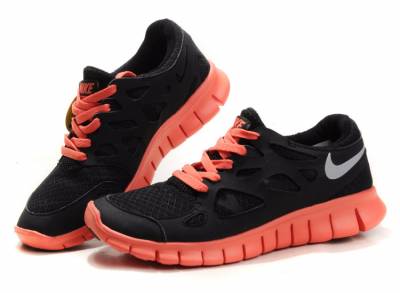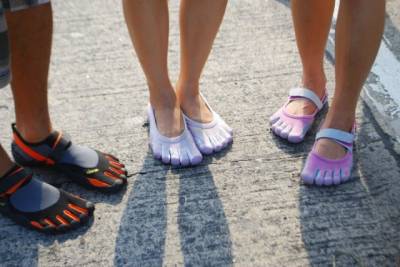The Controversy Behind Barefoot Running
Thursday, November 20, 2014

There's a real craze going on in the running community and no doubt you have heard the hype around it. So today, I want to share some valuable information on the controversial topic of barefoot running.
Quite simply, barefoot running, also known as minimalism or natural running, is running without shoes or running in thin-soled shoes. Running barefoot is considered to be the natural way of running and some entire cultures still foster this idea such as the Tarahumara in Mexico. Minimalists, or runners who run in minimal shoes or barefoot, argue barefoot running can correct a runner's form and foster a forefoot strike, which can result in fewer running injuries than those who run with a heel-strike.
Here's the controversy though:
Scientific research is still yet to reach a clear consensus on the benefits of the barefoot technique. Advocates of the technique argue minimal running is better for the feet in that it strengthens key support structures and reduces chronic injuries such as IT Band Syndrome, Runner's Knee, shin splints and other common running injuries. According to these proponents, barefoot running forces runners to fore strike as opposed to heel-strike, which is the result of the evolution of the running shoe to exhibit a cushioned heel.
Barefoot running remains a controversial topic and many argue it might not be suitable for all runners. We believe that there's no single answer or prescription that's right for every runner when it comes to footwear and running form. In 1960 Ethiopia's Abebe Bikila, the greatest Olympic marathoner of all time, won the first of his consecutive gold medals sans shoes in a world record 2:15:17. While Bikila was making Olympic history, England's Bruce Tulloh was running European record times from 1955 to 1967, almost always in bare feet.
Still, it wasn't until 2009 that barefoot running became a hot topic. The biggest impetus was Christopher McDougall's book Born to Run. The popularity of minimal shoes, such as the Nike Free and Vibram Five-fingers, has fuelled the fire.

Why Run Barefoot?
In terms of racing, studies have proven that less weight on your feet will improve your running efficiency and decrease your time. Research has also shown that barefoot running forces the foot to impact the ground differently.
Running shoes typically make runners strike the ground with their heel first, whereas barefoot running changes the gait pattern to a forefoot strike. Many barefoot runners say they are more comfortable with the change though, since the forefoot strike is a natural motion for most runners. But for runners who are naturally rear foot strikers, barefoot runs can put stress on the Achilles tendon and lead to injuries. For the average runner, the benefits may not outweigh the advantages when it comes to barefoot running. Because of the higher risk of puncture wounds, infection and other potential injuries, many podiatrists, physiotherapists and doctors, suggest incorporating barefoot running into your routine, rather than ditching your shoes altogether if you are interested in pursuing this technique.

How to Start Running Barefoot:
The more minimal a shoe the more your foot, ankle and lower leg have to work to maintain and support your body in motion. This means that the foot, ankle and calves have to be stronger. While minimalism may not be for all runners, most runners can benefit from strengthening their lower leg. Whether you're trying to transition to barefoot running or just trying to build strength, the transitioning process is beneficial to all runners. Here are some practical tips to assist transitioning to barefoot running. Before you attempt any training program or start barefoot running, make sure you first of all contact your practitioner for a personalised biomechanical assessment to see whether it's appropriate or even safe for you first.
Simple tips to begin strengthening to transition to barefoot running:
1. Strengthen the lower body and core.
2. Practice weight-bearing strength exercises barefoot such as walking or using the elliptical trainer with a more minimalist shoe.
3. Begin to incorporate short intervals (seconds to minutes) of barefoot walking around the house while continuing to use minimal shoes walking or on the elliptical trainer or treadmill.
4. Learn how to run barefoot- This way your body learns the natural running motion and it will be translated when using a minimalist shoe. This is a drill with the specific purpose to learn the mechanics of running with less underfoot. Some runners know this naturally but most, when they put on a minimalist shoe, run the same way as they do in a supportive running shoe (hint:not good). If this is the case, take your time and learn this step. You have to learn to crawl before you run and you also need to learn to run without (barefoot) before you run farther with less (minimalist).
5. Practice patience and flexibility. Because running in minimalist shoes with natural form uses a host of other muscles (specifically your calves and muscles in your feet) if you plug these shoes (minimalist) into your regular running plan like any new pair of shoes, you will be at a very high risk of developing calf, Achilles, and other foot injuries. Think of this as a tool on your toolbox—and a strengthening tool at that.
To see if barefoot running may be a good option for you, please take the best advice first by reaching out to our practice so we can ensure you are safe and well prepared if you wish to head down this path.
